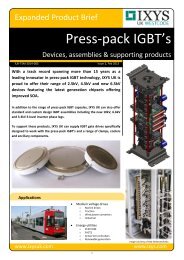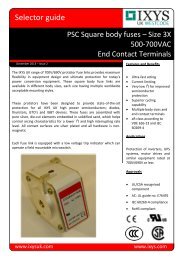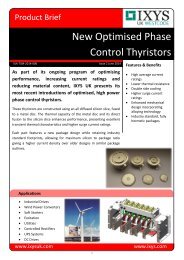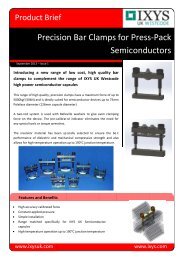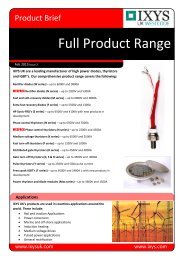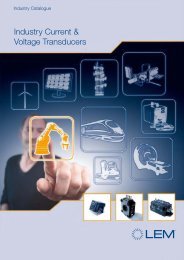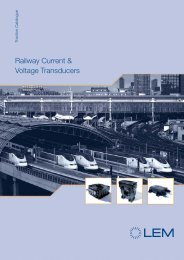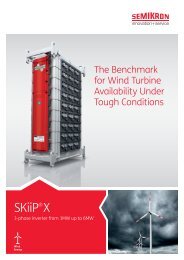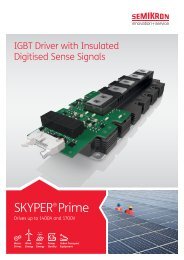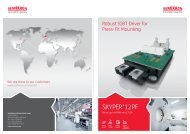isolated current voltage transducers
Create successful ePaper yourself
Turn your PDF publications into a flip-book with our unique Google optimized e-Paper software.
Isolated Current and Voltage Transducers<br />
Characteristics - Applications - Calculations<br />
1 Optimal solutions with 6 different<br />
technologies of LEM <strong>transducers</strong> 4<br />
2 Determining parameters for transducer<br />
selection 5<br />
2.1 Which parameters need to be considered ? 5<br />
2.2 Understanding the LEM documentation 5<br />
2.3 Additional selection criteria 5<br />
2.4 Current <strong>transducers</strong> – selection check list 6<br />
2.5 Voltage <strong>transducers</strong> – selection check list 8<br />
2.6 Power <strong>transducers</strong> – selection check list 8<br />
2.7 Type of output 8<br />
3 Hall effect technologies 9<br />
3.1 Open loop Hall effect <strong>current</strong> <strong>transducers</strong> 9<br />
3.1.1 Construction and principle of operation 9<br />
3.1.2 Advantages and limitations 10<br />
3.1.3 Nominal and extreme <strong>current</strong>s 10<br />
3.1.4 Output signals 10<br />
3.1.5 Measurement accuracy 10<br />
3.1.6 Magnetic offset considerations 10<br />
3.1.6.1 Demagnetization to eliminate magnetic offset 10<br />
3.1.7 Bandwidth and core losses 11<br />
3.1.7.1 Core losses 11<br />
3.1.7.2 Core loss rule-of-thumb 11<br />
3.1.7.3 A core loss example 11<br />
3.1.7.4 Addressing core losses 12<br />
3.1.8 Response time, delay time, and di/dt behavior 12<br />
3.1.9 Typical applications 12<br />
3.1.10 Calculation of the measurement accuracy 13<br />
3.2 Closed loop Hall effect <strong>current</strong> <strong>transducers</strong> 13<br />
3.2.1 Construction and principle of operation 13<br />
3.2.2 Advantages and limitations 14<br />
3.2.3 Nominal and extreme <strong>current</strong>s 14<br />
3.2.4 Output signal – Measurement resistance 14<br />
3.2.5 Measurement accuracy 14<br />
3.2.6 Observations regarding magnetic offset 15<br />
3.2.7 Bandwidth and core losses 15<br />
3.2.8 Response time and di/dt behavior 15<br />
3.2.9 Typical applications 15<br />
3.2.10 Transducer parameter examples 16<br />
3.2.11 Calculation of the measurement accuracy 19<br />
3.2.12 Unipolar power supply 20<br />
3.3 Eta Technology Hall effect <strong>current</strong> <strong>transducers</strong> 20<br />
3.3.1 Construction and principle of operation 20<br />
3.3.2 Advantages and limitations 21<br />
3.3.3 Nominal and extreme <strong>current</strong>s 21<br />
3.3.4 Output signal 21<br />
3.3.5 Measurement accuracy 21<br />
3.3.6 Dynamic behavior 21<br />
3.3.7 Typical applications 21<br />
3.4 Closed loop Hall effect <strong>voltage</strong> <strong>transducers</strong> 21<br />
3.4.1 Construction and principle of operation 22<br />
3.4.2 Voltage transducer with internal resistor 22<br />
3.4.3 Voltage transducer without internal resistor 22<br />
3.4.4 Transducer Output 24<br />
3.4.5 Typical applications 24<br />
3.5 Other Hall effect <strong>voltage</strong> <strong>transducers</strong> 24<br />
4 Fluxgate technologies 25<br />
4.1 Working principle of Fluxgate technologies 25<br />
4.1.1 „Standard“ Fluxgate – working principle 25<br />
4.1.2 Sensing head – a <strong>current</strong> response to a <strong>voltage</strong> step 26<br />
4.1.3 Detecting the sensing head inductance variation 27<br />
4.1.4 Current transformer effects 27<br />
4.2 Existing types of Fluxgate transduers 28<br />
4.3 General performance of Fluxgate technologies 28<br />
4.4 „C-type“ Fluxgate <strong>transducers</strong> 28<br />
4.4.1 Construction and principle of operation 28<br />
4.4.2 „CT-type“ <strong>current</strong> <strong>transducers</strong> 29<br />
4.4.3 „CD-type“ differential <strong>current</strong> <strong>transducers</strong> 29<br />
4.4.4 „CV-type“ <strong>voltage</strong> <strong>transducers</strong> 30<br />
4.4.5 „C-type“ <strong>transducers</strong> - typical applications 30<br />
4.4.6 Calculation of the measurement accuracy &<br />
noise rejection 30<br />
4.5 „IT-type“ Fluxgate <strong>transducers</strong> 31<br />
4.5.1 Construction and principle of operation 31<br />
4.5.2 „IT-type“ <strong>transducers</strong> – advantages & limitations 33<br />
4.5.3 „IT-type“ <strong>transducers</strong> - typical applications 33<br />
4.5.4 Calculation of the measurement accuracy 33<br />
5 Air-core technologies 34<br />
5.1 Basic working principle and sensitivity 34<br />
5.2 LEM~flex - the flexible AC <strong>current</strong> transducer 34<br />
5.2.1 Construction and principle of operation 34<br />
5.2.2 Characteristics and features 35<br />
5.2.3 Typical applications 35<br />
5.2.4 Calculation of the measurement accuracy 36<br />
5.3 PRiME TM Transducers 36<br />
5.3.1 Construction and Principle of Operation 36<br />
5.3.2 Characteristics and Features 37<br />
5.3.3 Advantages and Limitations of PRiME Technology 37<br />
6 Other types of <strong>voltage</strong> transducer<br />
technologies 38<br />
6.1 OptiLEM <strong>voltage</strong> <strong>transducers</strong> 38<br />
6.2 „AV type“ <strong>voltage</strong> <strong>transducers</strong> 39<br />
6.2.1 Construction and Principle of Operation 39<br />
6.2.2 Characteristics and Features 39<br />
6.2.3 Typical applications 40<br />
6.2.4 Calculations & Properties 40<br />
7 Current probes 41<br />
8 Miscellaneous 42<br />
8.1 Power supply polarity inversion 42<br />
8.2 Capacitive dv/dt noise 42<br />
8.3 Magnetic disturbances 42<br />
8.4 Typical misapplication of a transducer parameter 43<br />
8.5 LEM ASIC based <strong>transducers</strong> 43<br />
9 LEM – the leader in electrical parameter<br />
measurement 44<br />
10 Glossary A-Z 45<br />
3





